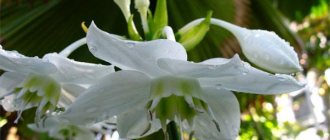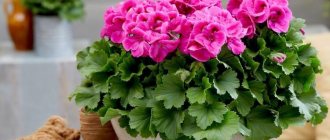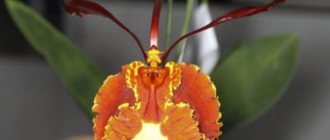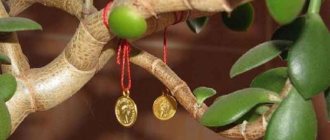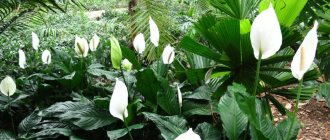Guzmania is a popular plant for growing at home, which always attracts the attention of buyers in flower shops. It looks equally advantageous at home or in the office, since vigorous flowering can add rich colors and diversify the interior.
In its homeland, this flower was considered a symbol of masculinity and men's health. They believed that the presence of guzmania in the house prolongs the life of the owner and gives him vigor and strength. Studies of bioenergetics have shown that culture can improve the atmosphere and tone people up, have a good effect on sleep, making it sound and deep, and also calm and relieve depression. If we add to this the plant’s ability to purify the air from many harmful substances, it becomes clear that this is not only a great purchase for yourself, but also a good gift for people who love indoor floriculture.
When is it time to replant a flower?
Planting in a new pot is done only once - after purchase, in order to create favorable conditions for the growth and development of Guzmania and not disturb it anymore. In other cases, only children are transplanted at home for further reproduction.
Types of flowering
Important! The plant must be replanted carefully by transferring it from the previous location to a new pot. It is important to preserve the earthen ball around the roots as much as possible, since the roots of the plant are very thin and fragile.
How to propagate Guzmania
Guzmania: plant transplantation and home care
Flower planting can be done after the plant has finished blooming. Around the base, lateral shoots (babies) are formed, on which a separate root system appears. As soon as the length of the root has reached 1.5 cm, the sprout must be cut off with a very sharp tool and the cut should be treated with garden varnish or crushed activated carbon. The second propagation option is using seeds.
Root system
Main characteristics
Guzmania is a herbaceous plant that belongs to the Bromeliads, that is, it is a relative of the pineapple. Its homeland is considered to be the rainforests of India, Brazil, America and Venezuela.
The genus was named in honor of the Spaniard Guzman, who first described this plant in detail, and in botanical nomenclature it correctly sounds like “Guzmania”. But due to an incorrect reading of the Latin version, the name “Guzmania” stuck, which is now used even by some experts.
Since the flower is an epiphyte, the root system is not very developed. Nutrition occurs partially through a cup at the base of the rosette, in which moisture accumulates. The supply of water in nature is used not only by plants, but also by many birds or insects that use such natural reservoirs to quench their thirst.
The culture is valued for its long decorative flowering, which lasts up to four months.
It first appears at the age of 4-6 years. The bright top is not actually a flower, it is modified leaves that become brightly colored to attract pollinators to the very small and inconspicuous reproductive flowers. In some species, cleistogamy is observed, that is, the bud never opens, and self-pollination occurs inside it at this time. After flowering, the flower dies after about six months.
Guzmania - transfer
Monstera - home care, transplantation and reproduction
If necessary, you can replant the plant at any time. But it is better to choose the spring months of the year for this, so that the plant blooms in the summer.
What happens if the children are not sent away?
After the mother plant has flowered and the babies have formed, the main plant begins to die. You need to wait until it completely dries and remove it, and the children will take root in the existing pot, if its size allows this.
Death of the mother plant
Preparing for transplant
In addition to purchasing a pot, before replanting it is necessary to carefully treat the plant and prepare the soil.
Choosing a pot
The container needs to be massive so that the bush does not turn over, because the upper part may become heavier than the lower part over time. The depth of the pot should be no more than 12 cm, and the diameter should be up to 15 cm, that is, you need a low but wide container. The deeper it is, the greater the likelihood of soil rotting, which the root system does not reach.
Drainage preparation
Drainage makes up 1/3 of the entire pot. It serves to absorb excess moisture. For this purpose, you can use expanded clay, wood charcoal, polystyrene foam, or a mixture of these substances.
Drainage
It is best to use more coal, it will act as an anti-infective agent. The rest of the filling of the pot should consist of crushed moss, peat or old wood, because this is the natural habitat of the flower.
Plant treatment
When replanting an adult plant, you need to remove old, dry or damaged roots and treat the cut areas. It is better to treat the roots of the children, which are separated from the main plant, with a growth stimulating agent.
How to transplant Guzmania at home
Guzmania - home care, transplantation and reproduction
In order for the transplant to take place quickly and without problems, you need to prepare in advance everything that will be needed:
- a sharp knife, having previously treated it with alcohol;
- spatula;
- growth agent;
- pot.
To replant an adult plant, it is cleared of old roots. Next, the soil is processed and slightly dried. Transfer the guzmania to a new container and add fresh soil.
Transplanting a plant
How to transplant Guzmania babies:
- Carefully separate the babies from the main plant with a knife.
- Transfer them to paper and let dry for one hour.
- Place a drainage layer equal to 1/3 of the total volume at the bottom of the pot. Sprinkle a small amount of soil on top and place a young sprout in the center.
- Gently straighten the roots and cover with the rest of the prepared soil until the roots are completely covered.
- Compact, but do not water the soil, but only lightly spray it with a spray bottle.
Note! The soil should not be flooded so that the roots can get used to the new habitat and not deteriorate at an early stage.
For best results, the children should be planted in a separate pot filled with orchid soil. Place it in a warm room and cover it with polyethylene to create increased humidity.
Caring for the plant after transplantation
In order for the work to produce results, it is necessary to observe proper care after transplanting Guzmania.
Location and contents
In winter and spring, the temperature in the room should not exceed 21 degrees Celsius, humidity should not be lower than 60%. The pot should be placed away from direct rays and heat sources. In summer and autumn, the plant needs a temperature of +20...+25 degrees, humidity - from 65 to 80%. Direct sunlight should hit the guzmania only after lunch. To maintain humidity at the required level, place the pot on a stand with moistened moss.
How to water and fertilize
The water should be filtered and at room temperature. Watering is not done on the ground, but inside the plant. If liquid remains inside the socket, it must be drained or wetted with a napkin. To prevent rotting, in summer watering should be done 2 times a day; in winter, 1 time a week is enough.
How to water Guzmania
Guzmania does not need fertilizer, since the composition of the soil already nourishes it. But you can fertilize to continue flowering. Any of the selected products must be dissolved in water.
Note! The dose should be reduced by 4 times from what is indicated on the package.
Reproduction
There are 2 ways to propagate a flower - by seeds and by separating shoots. The plant lives up to 3 years, and when buying an adult plant you need to be prepared for the fact that it will soon wither. During this time, you will need to propagate Guzmania with the help of children. Propagation by seeds is more painstaking work.
Diseases and pests
Improper care of the crop can lead to damage to the leaves by various diseases. The most common is gray rot. It appears in the form of gray spots on the leaf blades, as in the photo. You can fight rot if you notice it in a timely manner. Fungicides are used and sprayed onto the leaf blades until signs of the disease disappear.
Sometimes parasites appear on the leaves. You can recognize their appearance by a sticky whitish film or plaque. In this case, you need to prepare a soap solution and wipe all the leaf plates with a cloth soaked in it. After this, the plant is treated with an insecticide. Fitoverm and Aktelika help a lot.
Errors
To achieve flowering of a new plant and further reproduction, pay attention to possible errors:
- The plant does not bloom. If a child does not form a flower at home after transplantation, it means there is not enough light for her and the room is not humid enough.
- Decay. To correct the situation, you need to reduce the frequency and abundance of watering.
- Death of children. Immediately after transplantation, the flower may wilt and dry out. It is necessary to check the temperature in the room, it must meet the above criteria.
- Guzmania quickly fades. The reason is that when watering, moisture remained on the petals. The solution to the problem is to water the soil during flowering.
- The shoot is growing slowly. It depends on the quality of the water. It should be warm and filtered.
- Diseases. They can only occur if the sections were not processed during transplantation.
- Drying of the plant. This happens if the root has not yet been formed during transplantation.
- The tips of the leaves dry out. This is a sign of increased dry air in the room. After transplanting the babies, they need to be sprayed more often.
The tips of the leaves of the flower dry out
These are the most important rules for caring for Guzmania. To avoid disease and death of the flower, they must be observed very carefully. Otherwise, you will have to grow the plant again until you get the expected result.
Types and varieties
People who first encounter the Guzmania Mix plant mistake the brightly colored peduncles for flowers. In fact, these are just bracts.
The bright color of the bract is created by nature to attract insects to the small, yellow-white flowers hiding inside.
For cultivation at home, breeders have chosen several species, on the basis of which hybrids with different colors of bracts have been created. So guzmania lingulata or Reed is presented in several varieties, blooming in bright red, white-pink or orange. Less common is Guzmania Hilda with a yellow peduncle.
Minor rondo (guzmania minor roundel)
One of the most common representatives of indoor bromeliads. The rosette is small, the leaves are 2-3 centimeters wide and no more than 15 cm long. Guzmania Minor Rondo can have a wide variety of colors, most often all shades of red and orange. The culture loves good lighting and feels great on windowsills on the east or west side.
Guzmania Minor responds well to fresh air, so in summer it can be taken out onto the balcony.
Tempo (guzmania tempo)
A variety similar in flowering shades to Minor, but more demanding in terms of placement. The leaves of the crop are large, up to 5-6 centimeters wide, and grow up to 30 cm in length, so Guzmania Tempo will not fit on the windowsill. It is best to install it on a stand next to a window so that the plant has enough light. Tempo blooms with small white flowers hidden in a red or orange tip.
Ostara (guzmania ostara)
A distinctive feature of the variety is the pronounced glossy surface of the leaves and bracts.
The leaf blades are light green, the peduncle, covered with smaller leaves, is scarlet with a hint of orange. The species blooms for a very long time - up to six months. Guzmania Ostara reproduces well by transplanting children.
Mosaic (guzmania musaica)
An original plant with an unusual coloring of leaf blades and a short peduncle. The leaves are wide and long (up to 70 cm), decorated with light green “spots” or stripes over the entire surface.
Donnell Smith (guzmania donnell smithii)
Bracts are red. The leaves are long and leathery. During flowering, the peduncle resembles a short pyramid with red and yellow hues. Blooms in February. In its natural environment, the species grows in Costa Rica. It is one of the few suitable for rapid propagation by seeds.
Tsana (guzmania zahnii)
A very large variegated species. The leaves reach 70 cm in length. The bracts are red with yellow tips. Several yellow “bumps” form at once in the middle. The species has several domestic varieties; you can choose the original guzmania from the photo, buy and propagate it yourself.
Single-eared (guzmania monostachia)
Those who have already mastered growing exotics can diversify their collection with this species. It is unusual and has high decorative qualities. The leaves are long, thin, green at the base and yellow at the pointed ends. The peduncle is long with red bracts, from under which white seed pods “peek out”.
Lingula (guzmania lingulata)
A favorite among gardeners, it has a compact bush and beautiful red-orange bracts. Guzmania reed was taken by breeders as the basis for breeding such unusual hybrid varieties as:
- Fiery;
- Purple;
- Regular;
- Modest-flowered.
The compact rosette of bracts becomes colored in mid-February. Flowering lasts 3-4 months.
Blood red (guzmania sanguinea)
In April, this species develops a red rosette of bracts.
The peculiarity of the species is that throughout the entire flowering period, which lasts until August, they change shade from burgundy-red to scarlet, purple-pink.
Guzmania flowers are almost invisible, they are small, white, hidden in a large funnel.
Nicaraguan (guzmania nicaraguensi)
A type of guzmania adapted for growing in a pot indoors. The leaf blades are densely packed, narrow, and light green. The spike-shaped inflorescence of bracts is bright red below, and the apex is made up of yellow flowers.
Guzmania "Conifera" (Conifera)
Guzmania "Glow"


